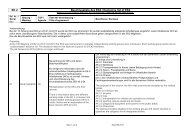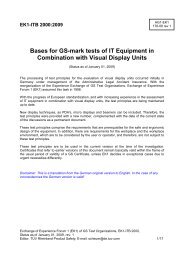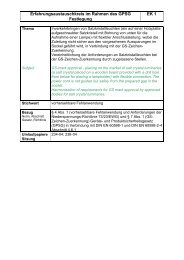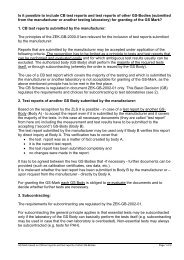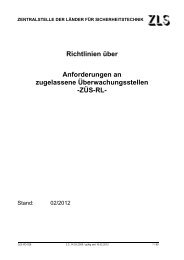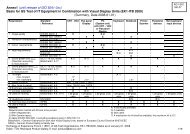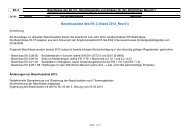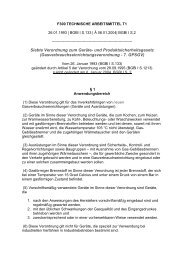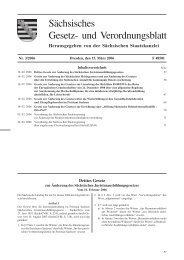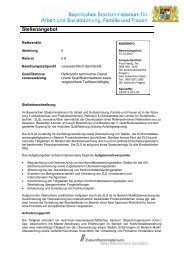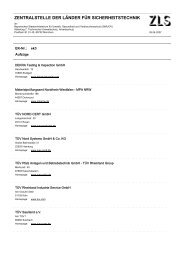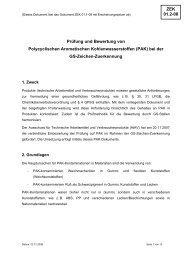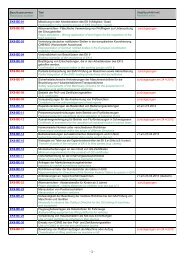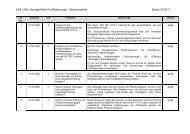EK1-ITB 2000:2010 - ZLS
EK1-ITB 2000:2010 - ZLS
EK1-ITB 2000:2010 - ZLS
- No tags were found...
You also want an ePaper? Increase the reach of your titles
YUMPU automatically turns print PDFs into web optimized ePapers that Google loves.
<strong>EK1</strong>-<strong>ITB</strong> <strong>2000</strong>:<strong>2010</strong>A.1 General PrinciplesA.1.1 Guidelines and Laws2006/95/ECDirective 2006/95/EC of the European Parliament and of the Council of 12December 2006 on the harmonisation of the laws of Member States relating toelectrical equipment designed for use within certain voltage limits (codified version).89/336/EECCouncil Directive of 3 May 1989 on the approximation of the laws of the MemberStates relating to electromagnetic compatibility, implemented in Germany by theElectromagnetic Compatibility of Equipment Act.(replaced by 2004/108/EC)2004/108/ECDirective of the European Parliament and of the Council of 15 December 2004 onthe approximation of the laws of the Member States relating to electromagneticcompatibility and repealing Directive 89/336/EEC.90/270/EECCouncil Directive of 29 May 1990 on the minimum requirements concerning thesafety and health protection during work on visual display units (Individual Directivein the context of Article 16, Clause 1 of Directive 89/391/EEC), implemented inGermany by the Ordinance on Visual Display Units (Occupational Safety Law, 19.December 1998 version).93/68/EECCouncil Directive of 22 July 1993 on the amendment of the above-mentionedDirectives.98/37/ECCouncil Directive of 22 June 1998 on the approximation of the laws of the MemberStates relating to machinery, implemented in Germany by the ninth ordinance tothe Technical Plant and Equipment Act.2001/95/ECDirective of the European Parliament and of the Council of 3. December 2001 ongeneral product safety.German Product Safety & liability law (GPSG)dated January 6, 2004 including therein named changes of ordinances of theoverrulled GSG (Product Safety Law).Exchange of Experience Forum 1 (<strong>EK1</strong>) of GS Test Organizations, <strong>EK1</strong>-<strong>ITB</strong> <strong>2000</strong>, 01.01.<strong>2010</strong>Editor: TÜV Rheinland Product Safety; E-mail: scheuer@de.tuv.com 2/17
<strong>EK1</strong>-<strong>ITB</strong> <strong>2000</strong>:<strong>2010</strong>DIN 2137 Part 6DIN 2137 Part 6,Annex 1DIN 2137 Part 10DIN 2137 Part 11DIN 2137 Part 12Annex 1 to DIN 2137DIN EN ISO 9241-1DIN EN 29241 - 2DIN EN 29241 - 3DIN EN ISO 9241-4DIN EN ISO 9241-6Text and office systems - Keyboards - Part 6: Germankeyboard for data and text processing as well as fortypewriters; key arrangement and allocation of functionsto keysText and office systems - Keyboards - Part 6: Germankeyboard for data and text processing as well as fortypewriters; information on the symbols to be used torepresent functionsText and office systems - Keyboards - Part 10: Germankeyboard for data and text processing as well as fortypewriters; arrangement of key positions and keydistancesText and office systems - Keyboards - Part 11: Germankeyboard for data and text processing as well as fortypewriters; principles governing the allocation of graphiccharacters or of functions to keys and the placement oftheir symbols on the keysText and office systems - Keyboards - Part 12: Germankeyboard for data and text processing; key arrangementand allocation for portable computersText and office systems - Keyboards - German keyboarddata and text processing as well as for typewriters;information on graphic keys and the allocation of graphiccharacters or symbolsErgonomic requirements for office work with visualdisplay terminals (VDTs) - Part 1: General introduction(ISO 9241-1:1997); German version EN ISO 9241-1:1997Ergonomic requirements for office work with visualdisplay terminals (VDTs); part 2: guidance on taskrequirementsErgonomic requirements for office work with visualdisplay terminals (VDTs); part 3: visual displayrequirements(replaced by ISO 9241-3xx)Ergonomic requirements for office work with visualdisplay terminals (VDTs) - Part 4: Keyboard requirementsfor visual display terminals (ISO 9241-4:1998); Germanversion EN ISO 9241-4:1998Ergonomic requirements for office work with visualdisplay terminals (VDTs) - Part 6: Guidance on the workenvironmentExchange of Experience Forum 1 (<strong>EK1</strong>) of GS Test Organizations, <strong>EK1</strong>-<strong>ITB</strong> <strong>2000</strong>, 01.01.<strong>2010</strong>Editor: TÜV Rheinland Product Safety; E-mail: scheuer@de.tuv.com 6/17
<strong>EK1</strong>-<strong>ITB</strong> <strong>2000</strong>:<strong>2010</strong>A2.9 Further decisions from meetings of the Exchange of Experience Forum 1(<strong>EK1</strong>) and its Working Group AG1A.2.9.1A.2.9.2A.2.9.3A.2.9.4A.2.9.5A.2.9.6A.2.9.7A.2.9.8A.2.9.9A.2.9.10Keyboards (1 st meeting AG1 <strong>EK1</strong>):If the key board does not comply with the above mentioned standards, decisionsmust be made for special groups of users.Keyboard caps, labelling of the front side (4 th meeting AG1 <strong>EK1</strong>):In principle the same requirements apply as for labelling of the topside.Notebooks, keyboard height (4 th meeting AG1 <strong>EK1</strong>):Cancelled - 12 th meeting AG1 <strong>EK1</strong>Gloss of keyboard and housing (4 th meeting AG1 <strong>EK1</strong>):The evaluation of the contrast and the gloss of keyboards and housings are to bemade with consideration of the manufacturer's specification for the intended use.If no other life cycle is indicated by the manufacturer or specifications are made bystandards, the values on key caps are to be judged after 5 million cycles.Specification for antireflection coating of monitors (4 th meeting AG1 <strong>EK1</strong>):Monitor class or targeted application is to be indicated on the certificate.Specification for noise in certificates (5 th meeting AG1 <strong>EK1</strong>):For the orientation of the operator the emitted sound pressure level and soundpower level are to be indicated on the certificate for operation in standby and fullperformance mode, according to DIN EN ISO 7779 and DIN EN ISO 29295.Keying feedback (5 th and 6 th meeting AG1 <strong>EK1</strong>):Actuation of a key shall be accompanied by a feedback. The feedback can bekinaesthetic (key displacement with snap function) or not kinaesthetically (keydisplacement with ramp function) accompanied by an auditory feedback. Theauditory feedback can take place in terms of hardware solution (e.g. by aloudspeaker integrated in the keyboard) or by software solutions (e.g. as part ofthe operating system). The today generally used kinaesthetic feedback issufficient, not however an end-impact noise.Segmented keyboards (4 th meeting <strong>EK1</strong>):Cancelled – replaced by A.2.9.13Video graphic boards (3 rd meeting <strong>EK1</strong>):Video graphic boards are not qualified for a GS-Mark.Keyboards, abrasion test (7 th meeting AG1 <strong>EK1</strong>):The abrasion test with synthetic sweat in its present form is confirmed. Testingwith diluted (thin) Oil of Olaz can be accepted only, when the proof is produced,that the results are equivalent.Exchange of Experience Forum 1 (<strong>EK1</strong>) of GS Test Organizations, <strong>EK1</strong>-<strong>ITB</strong> <strong>2000</strong>, 01.01.<strong>2010</strong>Editor: TÜV Rheinland Product Safety; E-mail: scheuer@de.tuv.com 9/17
<strong>EK1</strong>-<strong>ITB</strong> <strong>2000</strong>:<strong>2010</strong>A.2.9.11A.2.9.12A.2.9.13A.2.9.14A.2.9.15A.2.9.16Keyboards, DIN 60068-2-70 (7 th meeting AG1 <strong>EK1</strong>):Applicable for testing are DIN EN ISO 9241 part 4 in combination with DIN 60068-2-70 (in that order). The abrasion test shall be performed with the force of 1,5 N +20% as defined in DIN EN ISO 9241 part 4 for an applied force for keydisplacement and not with the values given by DIN EN 60068-2-70.Keyboards, laser inscription (7 th meeting AG1 <strong>EK1</strong>):The durability of legends with laser inscription has to be proofed with the testprocedures as intended in DIN EN ISO 9241 part 4. If a test confirms that thedurability of legends for a specific, qualified laser inscription procedure and clearlyspecified materials is given, specific tests could be skipped.Segmented keyboards (8 th meeting AG1 <strong>EK1</strong>):All participants agree, due to insufficient definition of test requirements, not toaccept test orders for such keyboards. Segmented keyboards with adjustableangle have to be tested in normal position according to ISO 9241-4 and DIN 2137.Character size on visual displays (8 Th meeting AG1 <strong>EK1</strong>):Due to some inconsistency in ISO 9241-3, the test is conducted with a charactersize of 20 min. of arc. Equivalent test pattern with horizontal or vertical lines maybe used if not otherwise specified by the manufacturer. An example for a 17” CRTis given in annex 2.Keyboard layout, Notebook keyboards (9 th + 12 th meeting AG1 <strong>EK1</strong>):The layout must be suitable for the intended user group. The tests are performedin accordance with DIN 2137-12.Deviations from test basisIn case of deviations from test basis <strong>EK1</strong>-<strong>ITB</strong> <strong>2000</strong> the following procedure apply:1. Preparation of an test report. The test report shows the deviation from the testbasis.2. Proof of necessity of the deviation.3. Presentation of the results within the Exchange of Experience Forum 1 (EK 1)Alternative test method for keyboards (addition):4. Performing of an user test concerning the acceptance of deviations by aqualified laboratory according to ISO 9241-4 and ISO 9241-115. Presentation of the results within the Exchange of Experience Forum 1 (EK 1)A.2.9.17A.2.9.18No longer considered.Evaluation of gloss within the direct field of viewCompany logos are not considered during gloss measurements.Exchange of Experience Forum 1 (<strong>EK1</strong>) of GS Test Organizations, <strong>EK1</strong>-<strong>ITB</strong> <strong>2000</strong>, 01.01.<strong>2010</strong>Editor: TÜV Rheinland Product Safety; E-mail: scheuer@de.tuv.com 10/17
<strong>EK1</strong>-<strong>ITB</strong> <strong>2000</strong>:<strong>2010</strong>A.2.9.19A.2.9.20A.2.9.21A.2.9.22A.2.9.23GS test with restricted scopeFor GS tests of IT equipment used within a restricted scope (like home area,entertainment, toys etc.) the test has to follow the test principles <strong>EK1</strong>-<strong>ITB</strong> <strong>2000</strong>.Deviations and their necessity shall be reported within the test report.No longer considered.No longer considered.No longer considered.Graphic boards (11 th meeting AG1 <strong>EK1</strong>):If a graphic board offers a analogue as well as digital output, the analogue outputhas to be evaluated due to expectation of higher quality at the digital output. Usethis procedure unless otherwise specified by the manufacturer.If a graphic board use different chip sets every version of the chip sets has to beevaluated.A.2.9.24Classic typewriters (11 th meeting AG1 <strong>EK1</strong>):DIN 2137 part 1 as well as all parts belonging to DIN 2137 have to be applied forelectronic typewriters.Exchange of Experience Forum 1 (<strong>EK1</strong>) of GS Test Organizations, <strong>EK1</strong>-<strong>ITB</strong> <strong>2000</strong>, 01.01.<strong>2010</strong>Editor: TÜV Rheinland Product Safety; E-mail: scheuer@de.tuv.com 11/17
<strong>EK1</strong>-<strong>ITB</strong> <strong>2000</strong>:<strong>2010</strong>A.2.9.25Gloss of housing for a server (12 th meeting AG1 <strong>EK1</strong>):The test of the gloss of housing for a server follows annex 1. Here the followingcriteria are used:Set-up Location of theserver*)Decision criteriaGS test accordingtoWithin a server room Without graphic board EN 60950 + noiseWith graphic board<strong>EK1</strong>-<strong>ITB</strong> <strong>2000</strong> incl.Gloss of housingWithin a server room With graphic board. The manufacturerdeclares that the set-up of the server ismade in the server room only and shall notbe in the field of vision of the user **)<strong>EK1</strong>-<strong>ITB</strong> <strong>2000</strong>withoutmeasurement ofthe gloss ofhousing*) Server = computer for data processing with or withoutgraphic board for use in server rooms**) Scope: Declaration of the manufacturer given in thebrochure and in the User’s Manual:The product is not suitable for use at visual displayworkplaces according to §2 of the German Ordinance forWork with Visual Display Units.Statements on the GS certificate:♦ Test specification♦ Hint that the tested product is not suitable for use atvisual display workplaces.A.2.9.26Pocket PC’s having a size larger than DIN A5 (12 th meeting AG1 <strong>EK1</strong>):For Pocket PC’s having a size up to DIN A4 the corresponding test principleshave to be applied. Therefore “sub-notebooks” are included as well.The minimum character size of 2,6 mm for key legends is applicable to charactersonly. Symbols like +, -, ; are excluded.A.2.9.27A.2.9.28User’s Manual (12 th meeting AG1 <strong>EK1</strong>):Safety relevant instructions of the User’s Manual have to be delivered in paperformat. It is not sufficient to store these instructions on a hard disk or a CD-ROM.repealed (17. meeting AG1 <strong>EK1</strong> decision A.2.9.33)Exchange of Experience Forum 1 (<strong>EK1</strong>) of GS Test Organizations, <strong>EK1</strong>-<strong>ITB</strong> <strong>2000</strong>, 01.01.<strong>2010</strong>Editor: TÜV Rheinland Product Safety; E-mail: scheuer@de.tuv.com 12/17
<strong>EK1</strong>-<strong>ITB</strong> <strong>2000</strong>:<strong>2010</strong>A.2.9.29A.2.9.30A.2.9.31Flat panel displays (13 th meeting AG1 <strong>EK1</strong>):The requirement of the inclination in front of the screen has not to be applied forflat panel displays.Data to be supplied in GS certificates (14 th meeting AG1 <strong>EK1</strong>):For clear and uniform presentation of information a minimum data are required inGS certificates for IT products (see appendix 6).Gloss of housing of peripheral devices (15 th / 22 meeting AG1 <strong>EK1</strong>):The requirements for the gloss of housing apply to peripheral devices used at thevisual display workplace according to BildscharbV. Peripheral devices intendedfor use outside the visual display workplace can receive a GS-Mark if the scope isindicated in the User’s Manual as well as the certificate.That means the following wording is possible in situations where the use withinthe field of view is not intended and where sufficient hints are given in the User’sManual for the avoidance of such situations to ensure that display work is notaffected.Wording in the certificate: “This device is not intended for use in the direct field ofview at visual display workplaces. To avoid incommoding reflexions at visualdisplay workplaces this device must not be placed in the direct field of view.”Note:(direct) field of view see ISO 8995, ISO 11064-4, EN 842, DIN 5340Exchange of Experience Forum 1 (<strong>EK1</strong>) of GS Test Organizations, <strong>EK1</strong>-<strong>ITB</strong> <strong>2000</strong>, 01.01.<strong>2010</strong>Editor: TÜV Rheinland Product Safety; E-mail: scheuer@de.tuv.com 13/17
<strong>EK1</strong>-<strong>ITB</strong> <strong>2000</strong>:<strong>2010</strong>A.2.9.32Reflections with „Bright View Notebooks” (16 th meeting AG1 <strong>EK1</strong>):The GS certification for notebooks is possible, if <strong>EK1</strong>-<strong>ITB</strong> <strong>2000</strong> and ISO 9241-3xxare fulfilled. In addition pay attention to the following:- Two test engineers have to evaluate the display surface by subjective andvisual inspection. Aim of this test is to assess disturbing reflections in theintended context of use.According to ISO 9241-307 the reflection classes have to be replaced byluminance and maximum illuminance values from ISO 9241-307:- If disturbing reflections are detected in case of L REF,EXT = 200 cd/m² and/orL REF,SML = <strong>2000</strong> cd/m² the intended context of use has to be described in moredetail within the safety instructions. A hint that the use in bright environmentsis restricted, e.g. during mobile use, must be given in the safety instructions aswell as the GS certificate.The statement depends on the intended context of use. Example:"During mobile use with disadvantageous illumination conditions (e.g. direct sunlight) reflections may occur which result in reduced readability.“Exchange of Experience Forum 1 (<strong>EK1</strong>) of GS Test Organizations, <strong>EK1</strong>-<strong>ITB</strong> <strong>2000</strong>, 01.01.<strong>2010</strong>Editor: TÜV Rheinland Product Safety; E-mail: scheuer@de.tuv.com 14/17
<strong>EK1</strong>-<strong>ITB</strong> <strong>2000</strong>:<strong>2010</strong>A.2.9.33Keyboard (17 th meeting AG1 <strong>EK1</strong>)A reduction of the key strokes for keyboards made of PBT material with laserinscription processes from 5 million to 2 million is possible if, after 2 million strokesa minimum contrast of 3,3:1 is achieved and the gloss level is under 20 glossunits.A reduction of the key strokes for keyboards with laser inscription processes from5 million to 4 million is possible if, after 4 million strokes a minimum contrast of3,3:1 is achieved and the gloss level is under 20 gloss units.The resolution A.2.9.28 is herewith nullified.Note: The gloss level of key caps can be determined alternatively with gloss levelplates (maximum matt or semi matt). (Hint: gloss templates/gloss level plates areavailable from Institut für Lackprüfung, Felsweg 19, 35435, Wettenberg,Germany).Exchange of Experience Forum 1 (<strong>EK1</strong>) of GS Test Organizations, <strong>EK1</strong>-<strong>ITB</strong> <strong>2000</strong>, 01.01.<strong>2010</strong>Editor: TÜV Rheinland Product Safety; E-mail: scheuer@de.tuv.com 15/17
<strong>EK1</strong>-<strong>ITB</strong> <strong>2000</strong>:<strong>2010</strong>A.2.9.34Application of DIN EN 50332-1/-2 (18 th and 19 th meeting AG1 <strong>EK1</strong>)The requirements of EN 50332 for limitations of the sound pressure level of ear-/headphone outputs is expanded to include stationary products with ear-/headphone outputs because they are subject to the same dangers regardinghearing damage/hearing loss. The following items have to be considered:1. Measurement procedureUse a) or b):a) Electric test (IT device without supplied ear-/headphone)In deviation to EN 50332 a measurement of the output voltage with adjustment ofthe volume control to center position has to be made with and without equalizer.During the measurements the equalizer is adjusted to its neutral or center position(factory setting). In case the reading is ≤ 150 mV the instructions for use mustconsider a warning note to fulfill the requirements according to <strong>EK1</strong>-<strong>ITB</strong> <strong>2000</strong>. Incase the reading is > 150 mV the requirements according to <strong>EK1</strong>-<strong>ITB</strong> <strong>2000</strong> arenot fulfilled.b) Acoustic test (IT device with supplied ear-/headphone)In case of a system (IT device with an ear-/headphone) the type of the ear-/headphone (manufacturer and model/type) has to be specified in the instructionsfor use. The requirements according to EN 50332-1 have to be fulfilled. Indeviation to EN 50332-1 the measurements shall be conducted with adjustment ofthe volume control to center position with and without equalizer. The instructionsfor use must contain a warning note.Informative: A measurement of the output voltage with adjustment of the volumecontrol and equalizer to maximum has to be carried out.2. Warning note (example)Excessive sound pressure from ear-/headphones can cause hearing damage/hearing loss.Adjustment of the volume control as well as the equalizer to other settings thanthe center position may increase the ear-/headphones output voltage andtherefore the sound pressure level.The use of factors influencing the ear-/headphones output other than thosespecified by the manufacturer (e.g. operating system, equalizer software,firmware, driver) may increase the ear-/headphones output voltage and thereforethe sound pressure level.The use of ear-/headphones other than those specified by the manufacturer maylead to heightened sound pressure level.3. Exemption with portable devices (Addendum 24 th meeting)Commission decision 2009/490/EC has to be considered for portable IT deviceswith the possibility to play music and/or video and within the intended context ofuse for predominant handheld use.Exchange of Experience Forum 1 (<strong>EK1</strong>) of GS Test Organizations, <strong>EK1</strong>-<strong>ITB</strong> <strong>2000</strong>, 01.01.<strong>2010</strong>Editor: TÜV Rheinland Product Safety; E-mail: scheuer@de.tuv.com 16/17
<strong>EK1</strong>-<strong>ITB</strong> <strong>2000</strong>:<strong>2010</strong>A.2.9.35The requirements for electronic scales with LCD indicators for the use in weighingwork stations are to adhere to Annex 7.Note: Products limited to one indicator line only are exempted.A.2.9.36A.2.9.37Input devices; keyboards (20 meeting AG1 Ek1)ISO TR 24784 is introduced into the testing principles in addition to DIN 2137 andISO 9995.Critical temperatures of hot surfaces likely to be touched (22 meeting AG1 Ek1)The following products with critical surface temperatures were identified and mustbe considered separately during testing:- Bottom side of a laptop- Head-/Earphone- Handheld ScannerIf the surface temperatures of CENELEC Guide 29 are exceeded a warning andsafety note must be given in the instructions for use to address proper use and toexclude contact with surfaces of high surface temperatures.Keyboards are not considered in CENELEC Guide 29.A.3 Contents of the Test documentation• product description• intended context of use• Test report according to DIN EN ISO/IEC 17025• Specifications for sound emission values according to Annex 1Annex 1: Tabular compilation of the ergonomic bases for the GS testing of IT devices incombination with visual display units.Annex 2: Test procedure for character heightAnnex 3: Cancelled - 12 th meeting AG1 <strong>EK1</strong>Annex 4: Requirements for flat panels for the GS-mark (Interpretation of ISO 9241-3xx)Annex 5: Requirements for Pocket PC’sAnnex 6: Specifications in a GS CertificateAnnex 7: Requirements for electronic scalesExchange of Experience Forum 1 (<strong>EK1</strong>) of GS Test Organizations, <strong>EK1</strong>-<strong>ITB</strong> <strong>2000</strong>, 01.01.<strong>2010</strong>Editor: TÜV Rheinland Product Safety; E-mail: scheuer@de.tuv.com 17/17
Annex 1Basis for GS Test of IT Equipment in Combination with Visual Display Units (<strong>EK1</strong>-<strong>ITB</strong> <strong>2000</strong>)AG1-<strong>EK1</strong>197-09RequirementStandard/ ReferenceVisualDisplayPC(System unit)KeyboardNonkeyboardinputdevicesNotebookPocket PC1 Image quality DIN EN ISO 9241-3xx X X X2 Input requirements DIN EN ISO 9241-4 X X 3) 8)DIN 2137 X 2) X 2) 8)DIN EN ISO 9241-9 X X 8)3 Sound power level L WAdand Sound pressure level L pAm(Operation according tomanufacturer)ISO 7779 (ISO 9296)BildscharbV, A 17.PrinterScannerPeripheraldevices(e.g.printerscanner)X 1) X 1) X 1) X 1) X 1) X 1) X 1)4 Tilt angle max. forward: BildscharbV, A 5. 5° 6)X 7)Tilt angle min. backward:≥ 5°≥ 5° 9)5 Swivel (rotation) BildscharbV, A 5. max. ± 180°6 Max. force to swivel BildscharbV, A 5. max. 100 N7 Brightness adjustable BildscharbV, A 3. X X 4)8 Contrast adjustable BildscharbV, A 3. X 4) X 4)9 Gloss of housing BildscharbV, A 8., A 15.DIN EN ISO 9241-3xx≤ 20 glossunits≤ 20 glossunits≤ 20 glossunits≤ 20 glossunits≤ 20 glossunits10 Headphone output EN 50332 X 5) X 5) X 5) X 5) X 5)11 Technical documentation GPSG X X X X X X X12 User’s manual GPSG X X X X X 8) X X≤ 20glossunits≤ 20 glossunitsRemark:Requirements marked with X have to be proved.1) With integrated fan. 6) only for CRT-VDU’s2) With German layout. 7) A mechanism for tilt shall be available, the maximum tilt is 15°.3) Apply DIN EN ISO 9241-4 excluding exeptions given in DIN 2137-12. 8) Pocket PC: see Annex 54) If technically provided. 9) Pocket PC: not applicable5) if availableBildscharbV = German Ordinance for work with Visual Display Units, based on European Council Directive 90/270/EEC, GPSG = German Product Safety & liability lawExchange of Experience Forum 1 (<strong>EK1</strong>) of GS Test Organizations, <strong>EK1</strong>-<strong>ITB</strong> <strong>2000</strong>, 01.01.<strong>2010</strong>Editor: TÜV Rheinland Product Safety; E-mail: scheuer@de.tuv.com, Note: In case of any inconsistencies the German original version is valid! 1/10
Annex 2Test procedure for character heigth: Example for 17“ CRT - VDUViewing distance: 500 mmResolution: 1024 x 768SystemconfigurationFont Character height Matrix Alternative test pattern forcharacter „m“Alternative testpattern forcharacter „e“Small fonts Arial 10 2,95 mm 20,3‘ 7 x 10 !###!###!!###!###!!###!###!!###!###!Large fonts Arial 10 3,7 mm 25,4‘ 9 x 12 !####!####!!####!####!!####!####!!####!####!!!!!########!!!!########!!!!!!!!############!!!!############!!!!Annex 3Cancelled - 12 th meeting AG1 <strong>EK1</strong>Exchange of Experience Forum 1 (<strong>EK1</strong>) of GS Test Organizations, <strong>EK1</strong>-<strong>ITB</strong> <strong>2000</strong>,01.01.<strong>2010</strong>Editor: TÜV Rheinland Product Safety; E-mail: scheuer@de.tuv.com,Note: In case of any inconsistencies the German original version is valid! 2/10
Annex 4Ergonomic Requirements for flat panels for GS-markDetermination of the intended context of use according to ISO 9241-307, (example)Element Attribut QuantificationUser Vision User with normal or to normal corrected vision of any age, 7 years or older(any literate user).EnvironmentTaskDesign screen illuminance, E STypical components of theillumination: Large aperture source(15°) and small aperture source(1°) illuminationIlluminantAmbient temperatureContent and perceptionAmount of informationImage typeDesign viewing distance, D design,viewDesign viewing direction, Θ D , Φ DDesign viewing direction range(angle of inclination and azimuth)Eye and head positionNumber of usersVertical 250 lx + 250 lx × cos(α) in offices, where α is the screen tilt angle.The screen tilt angle is considered to be 75°.1. L REF,EXT = 200 cd/m 2 and L REF,SML = 2 000 cd/m 2 (suitable forgeneral office use);2. L REF,EXT = 200 cd/m 2 or L REF,SML = 2 000 cd/m 2 (suitable for most,but not all, office environments);3. L REF,EXT = 125 cd/m 2 or L REF,SML = 200 cd/m 2 (requires a speciallycontrolled luminous environment).Dabei ist:L REF,EXT is the luminance of the large aperture source (15°) andL REF,SML is the luminance of the small aperture source (1°).CIE illuminant D65ambient temperature of approximate 15°C to 35°C is considered.Artificial informationPreferred screen size for sufficient amount of information with appropriateobject size and resolution.Still image, quasi-static or moving image is considered, if not otherwisespecified by the supplier.500 mmWithin a specific range of angles from the normal.Viewing cone with a single visual displayThe maximum inclination angle range Θ range is:Θ range = 2 × arctan(D active /2 × D design,view ). WhereD active is the diagonal of the active display area andD design,view is the design viewing distance.The design inclination angle is within 0° ≤ Θ D ≤ 40° – Θ range /2. The azimuthangle Φ is 0° bis 360°.NOTE This definition correspond to viewing direction range classClass viewing III of earlier ISO 13406-2.From fixed to moving.Typical single or multiple.Usage Display handling For this compliance route stationary display handling is considered, if nototherwise specified by the supplier.Exchange of Experience Forum 1 (<strong>EK1</strong>) of GS Test Organizations, <strong>EK1</strong>-<strong>ITB</strong> <strong>2000</strong>,01.01.<strong>2010</strong>Editor: TÜV Rheinland Product Safety; E-mail: scheuer@de.tuv.com,Note: In case of any inconsistencies the German original version is valid! 3/10
Annex 5:Ergonomic Requirements for Pocket-PC‘s (AG1 of <strong>EK1</strong>, 70-02)1. Definition: Pocket-PCPC with integrated Display, which is smaller than DIN A4 (12 th meeting AG1 <strong>EK1</strong>) and whichincludes an alphanumeric keyboard and/or a pen for data input and which is not used forsteady work of visual display tasks.2. Use of Pocket-PCIn general Pocket-PC’s are hold by hand or standy-situated on a table.3. Keyboard of Pocket-PC‘s (ISO 9241-4, ISO/IEC 9995):Clause Applicability/LimitationISO 9241-46.1.1 Palm-restsN/A6.1.2 Sections of the keyboardN/A6.1.3 Home row heightN/A6.1.4 Slope of the keyboardApply6.1.5 Profile of keyboardAnwenden6.1.6 Keyboard surfaces and material properties of keyboardsApply6.1.7 Keyboard placementN/A6.1.8 Keyboard slope adjustment mechanismN/A6.2.1 Key layout and center-line spacingN/A6.2.2 Keytop designMinimum 64mm²6.2.3 Key displacement and forceAnwenden6.2.4.1 GeneralApply6.2.4.2 Kinaesthetic feedbackN/A6.2.4.3 Auditory feedbackN/A6.2.4.4 Visual feedbackApply6.2.5 Rebound action (bounce)Apply6.2.6 Key roll-overApplyExchange of Experience Forum 1 (<strong>EK1</strong>) of GS Test Organizations, <strong>EK1</strong>-<strong>ITB</strong> <strong>2000</strong>,01.01.<strong>2010</strong>Editor: TÜV Rheinland Product Safety; E-mail: scheuer@de.tuv.com,Note: In case of any inconsistencies the German original version is valid! 4/10
6.2.7 Key repeat functionApply (Software)6.2.8.1 Graphical symbolsN/A6.2.8.2 Geometric design of key legendsApply6.2.8.3 Number and positioning of legendsN/A6.2.8.4 Durability of legendsApply6.2.9 Cursor keys and keys in the editing sectionApply modified6.2.10 Numeric keypadApply if applicable6.2.11 Keytop shapeApplyISO/IEC 9995Clause Applicability/LimitationISO 9995-17.4 Key location numbering requirementsAnwendbar8.1 Group positionsErsten Absatz nicht anwendenZweiten Absatz anwenden8.2 Level positions within one groupAnwendbar, wenn die drei Ebenen in einer Spalte dargestellt werdenClause Applicability/LimitationISO 9995-27 Arrangement and location of keys in the alphanumeric zone of thealphanumeric sectionN/A8 Functions of the alphanumeric zone of the alphanumeric sectionApplicableClause Applicability/LimitationISO 9995-35 Common secondary group layout: Applicable6 Complementary Latin group layout: ApplicableClause Applicability/LimitationISO 9995-45-10 Apply if presentClause Applicability/LimitationISO 9995-55-12 Apply grouping of Cursor keys only as „Cross“ or „Inverte T“ LayoutClause Applicability/LimitationISO 9995-75 Descriptions of functionsNot to apply as used keys are not commonly usedClause Applicability/LimitationISO 9995-85-6 Apply if presentExchange of Experience Forum 1 (<strong>EK1</strong>) of GS Test Organizations, <strong>EK1</strong>-<strong>ITB</strong> <strong>2000</strong>,01.01.<strong>2010</strong>Editor: TÜV Rheinland Product Safety; E-mail: scheuer@de.tuv.com,Note: In case of any inconsistencies the German original version is valid! 5/10
Annex 6: Data to be provided by the GS certificate (minimum)a) NotebookBezeichnung Beispiel Bezeichnung1 Zertifikat-Nr.Certificate No.123456789 2 AusstellungsdatumDate of Issue3 GenehmigungsinhaberLicense HolderNotebook GmbH4 FertigungsstätteManufacturing Plant5 Abbildung des PrüfzeichensFigure of test mark= GS-Zeichen der Prüfstelle 6 PrüfberichtsnummerTest Report No.7 PrüfgrundlagenTest basis8 Zertifiziertes Produkt(Geräteidentifikation)Certified Product(Product identification)9 Nennspannung/-frequenzRated VoltageRated Frequency10 NennstromRated Current11 SchutzklasseProtection Class12 LCD-Display/ModulLCD Panel13 PixelfehlerklassePixel Fault Class14 Geeignet für Umgebungen nach EN 12464-1Suitable for environments according to EN12464-115 vorgesehener Sehabstanddesign viewing distance16 vorgesehene Sehrichtung undSehrichtungsbereichdesign viewing direction and viewing directionrangeInhalt und WahrnehmungContent and perception17 SchalldruckpegelSound Pressure level18 deklarierter SchallleistungspegelDeclared Sound Power Level19 Gültigkeitsdauer des ZertifikatesCertificate valid until20 Name des ZertifizierersName of the person who does the certificationEN 60950-1<strong>EK1</strong>-<strong>ITB</strong> <strong>2000</strong>BezeichnungType designationXvc V/u HzS ANXyxxxx123Pef°Ui dBKl dB(A)uv.wx.yzV. Certus 21 Unterschrift desZertifizierersSignature of the personwho does the certificationCert GmbH, Certhausen22 Zertifizierungsstelle mit Angabe der AnschriftCertification Body inc. address23 Hinweis, dass dem Zertifikat eine Prüf- und Zertifizierungsordnung zugrunde liegt.Hint, that the certificate is based on Testing and Certification Regulations.24 Feststellung, dass das Produkt die Anforderungen des GPSG erfüllt.Statement, that the product meets the requirements of GPSG.Exchange of Experience Forum 1 (<strong>EK1</strong>) of GS Test Organizations, <strong>EK1</strong>-<strong>ITB</strong> <strong>2000</strong>,01.01.<strong>2010</strong>Editor: TÜV Rheinland Product Safety; E-mail: scheuer@de.tuv.com,Note: In case of any inconsistencies the German original version is valid! 7/10
) Flat Panel DisplayBezeichnung Beispiel Bezeichnung1 Zertifikat-Nr.Certificate No.123456789 2 AusstellungsdatumDate of Issue3 GenehmigungsinhaberLicense HolderDisplay GmbH4 FertigungsstätteManufacturing Plant5 Abbildung des PrüfzeichensFigure of test mark= GS-Zeichen der Prüfstelle 6 PrüfberichtsnummerTest Report No.7 PrüfgrundlagenTest basis8 Zertifiziertes Produkt(Geräteidentifikation)Certified Product(Product identification)9 Nennspannung/-frequenzRated VoltageRated Frequency10 NennstromRated Current11 SchutzklasseProtection Class12 LCD-Display/ModulLCD Panel13 PixelfehlerklassePixel Fault Class14 Geeignet für Umgebungennach EN 12464-1Suitable for environmentsaccording to EN 12464-115 vorgesehener Sehabstanddesign viewing distance16 vorgesehene Sehrichtungund Sehrichtungsbereichdesign viewing direction andviewing direction rangeInhalt und WahrnehmungContent and perceptionEN 60950-1<strong>EK1</strong>-<strong>ITB</strong> <strong>2000</strong>BezeichnungType designationXvc V/u HzS ANXyxxxx123Pcd/m² / cd/m²ef°19 Gültigkeitsdauer desZertifikatesCertificate valid until20 Name des ZertifizierersName of the person who doesthe certification22 Zertifizierungsstelle mitAngabe der AnschriftCertification Body inc. addressuv.wx.yzV. Certus 21 Unterschrift des ZertifizierersSignature of the person whodoes the certificationCert GmbH, Certhausen23 Hinweis, dass dem Zertifikat eine Prüf- und Zertifizierungsordnung zugrunde liegt.Hint, that the certificate is based on Testing and Certification Regulations.24 Feststellung, dass das Produkt die Anforderungen des GPSG erfüllt.Statement, that the product meets the requirements of GPSG.Exchange of Experience Forum 1 (<strong>EK1</strong>) of GS Test Organizations, <strong>EK1</strong>-<strong>ITB</strong> <strong>2000</strong>,01.01.<strong>2010</strong>Editor: TÜV Rheinland Product Safety; E-mail: scheuer@de.tuv.com,Note: In case of any inconsistencies the German original version is valid! 8/10
c) PC (Personal Computer)Item Example Item1 Zertifikat-Nr.Certificate No.123456789 2 AusstellungsdatumDate of Issue3 GenehmigungsinhaberLicense HolderPC GmbH4 FertigungsstätteManufacturing Plant5 Abbildung des PrüfzeichensFigure of test mark= GS-Zeichen der Prüfstelle 6 PrüfberichtsnummerTest Report No.7 PrüfgrundlagenTest basis8 Zertifiziertes Produkt(Geräteidentifikation)Certified Product(Product identification)9 Nennspannung/-frequenzRated VoltageRated Frequency10 NennstromRated Current11 SchutzklasseProtection ClassEN 60950-1<strong>EK1</strong>-<strong>ITB</strong> <strong>2000</strong>BezeichnungType designationXvc V/u HzS AN17 SchalldruckpegelUi dBSound Pressure level18 deklarierterKl dB(A)SchallleistungspegelDeclared Sound Power Level19 Gültigkeitsdauer des uv.wx.yzZertifikatesCertificate valid until20 Name des ZertifizierersName of the person who doesthe certificationV. Certus 21 Unterschrift des ZertifizierersSignature of the person whodoes the certification22 Zertifizierungsstelle mit Cert GmbH, CerthausenAngabe der AnschriftCertification Body inc. address23 Hinweis, dass dem Zertifikat eine Prüf- und Zertifizierungsordnung zugrunde liegt.Hint, that the certificate is based on Testing and Certification Regulations.24 Feststellung, dass das Produkt die Anforderungen des GPSG erfüllt.Statement, that the product meets the requirements of GPSG.Exchange of Experience Forum 1 (<strong>EK1</strong>) of GS Test Organizations, <strong>EK1</strong>-<strong>ITB</strong> <strong>2000</strong>,01.01.<strong>2010</strong>Editor: TÜV Rheinland Product Safety; E-mail: scheuer@de.tuv.com,Note: In case of any inconsistencies the German original version is valid! 9/10
Annex 7 Requirements for Electronic Scales7.1 DefinitionElectronic scales with indicators for the weighing of wares for use at cash registers andweihing work stations.Note: Products limited to a single indicator line are exempt.7.2 ApplicationElectronic scales are used at display terminal work stations (i.e. as weighing or measuringinstruments by employees of markets).The use/implementation usually takes place at stationary cash register and weighing workstations as well as at standing and sitting work stations.7.3 RequirementsElectronic scales with LCD indicators and display terminals must comply with the samerequirements as those for flat panel displays. The actual context of use (environment, task,user) are to be taken into consideration. For technologies other than LCD, the analogequivalent standardized requirements apply.Requirement Standard / Referenz Elektronic Scale1 Image quality DIN EN ISO 9241-3xx X 1)2 Input requirements DIN EN ISO 9241-4 –DIN 2137 –3 Sound power level L WAdSound pressure level L pAm(Operation according tomanufacturer)4 Tilt angle max. forward:DIN EN ISO 9241-9ISO 7779 (ISO 9296)BildscharbV, A 17.BildscharbV, A 5.Tilt angle min. backward:≥ 5°5 Swivel (rotation) BildscharbV, A 5. –6 Max. force to swivel BildscharbV, A 5. –7 Brightness adjustable BildscharbV, A 3. X8 Contrast adjustable BildscharbV, A 3. X 2)9 Gloss of housing(Reflexion)BildscharbV, A 8., A 15.DIN EN ISO 9241-3xx10 Headphone output EN 50332 2)11 Technical documentation GPSG X12 Instructions for use GPSG XX–≤ 20 gloss unitsRemarks:Requirements marked with an X must always be included1) Also included is an analysis of the character attributes of the variouscharacter sets as well as the contrast and reflection of the various colorcombinations.2) if technically providedExchange of Experience Forum 1 (<strong>EK1</strong>) of GS Test Organizations, <strong>EK1</strong>-<strong>ITB</strong> <strong>2000</strong>,01.01.<strong>2010</strong>Editor: TÜV Rheinland Product Safety; E-mail: scheuer@de.tuv.com,Note: In case of any inconsistencies the German original version is valid! 10/10



